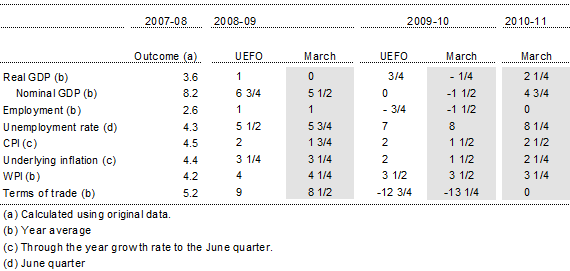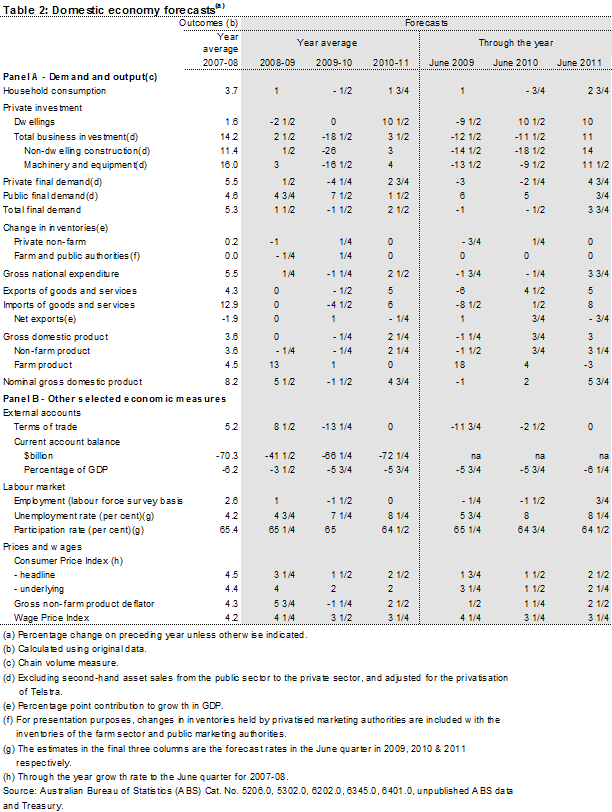The global economy has continued to slow with surprising speed as the corrosive effects of the financial crisis continue to detract from economic activity. Global trade volumes have plummeted and production and employment data suggest the world economy will experience a deeper recession in 2009 than expected at UEFO. In view of these developments, a recession in the domestic economy now appears inevitable.
Treasury's global growth forecasts have been downgraded by a full 1¾ percentage points since UEFO. World GDP is now forecast to contract for the first time in sixty years, shrinking by 1¼ per cent in 2009, slightly weaker than the IMF outlook. The speed at which the global outlook is deteriorating is reflected in the sharp contraction in global GDP in the December quarter which exceeded already pessimistic expectations. The decline was the largest in the post war era, and recent indicators point to another large decline in global GDP in the March quarter. Persistent financial market distress and low levels of confidence have led to downgrades in growth expectations for virtually every country.
In light of the deteriorating global outlook, GDP growth forecasts for Australia have been revised down to 0 per cent in 2008-09 and -¼ per cent in 2009-10, falls of 1 per cent in both years from UEFO expectations.
It has become clear that the effects of the global recession have impacted on domestic conditions more rapidly than initially thought, reflected in the 0.5 per cent fall in real GDP in the December quarter of 2008. In particular, household consumption did not hold up as strongly as partial indicators had suggested, with declines in real financial wealth and weaker confidence representing a substantial barrier to consumption growth. It now appears likely that the global crisis has dragged the Australian economy backwards by a similar amount in the March quarter 2009, and the economy is not expected to record positive growth until the first half of 2010.
Table 1: Key Domestic Forecasts - March compared with UEFO

Source: ABS Cat. No. 5206.0, 6345.0, 6401.0, 6202.0 and Treasury.
Weaker global conditions are impacting across the economy, with downward revisions to expectations across most sectors. The collapse in global demand has seen commodity prices fall sharply, with further falls expected as long term contracts are renegotiated in coming months. Exports contracted in the December quarter, but further significant declines are expected in light of the collapse in global trade and announced production cutbacks by major commodity exporters.
Business investment, recently at three decade highs as a share of the domestic economy, is unsustainable at these levels in the face of ongoing credit constraints, plummeting global trade volumes, falling commodity prices and a weak outlook for domestic demand. Sharp falls are expected over coming quarters, and business investment is now forecast to fall by 19 per cent in 2009-10, which would be the largest year average fall on record.
Fiscal and monetary policy are key to moderating the impact of global conditions on the domestic economy. Cash payments to households helped avoid a contraction in household consumption in the December quarter and will support consumption over the next 6 months, although underlying household consumption remains very weak as households struggle to rebuild their savings in the face of sharp falls in wealth and fears of job losses. Direct government expenditure flowing from the Nation Building and Jobs Plan and other packages will be critical to supporting demand over the forecast horizon, with public final demand expected to grow at its fastest rate in over a decade, and provide its largest contribution to GDP growth since the mid-1970s. Any slippage in this spending by the States will significantly weaken the outlook, particularly in 2009-10.
Monetary policy has been eased significantly and would be expected to rekindle investment in the dwelling sector and bolster household consumption over time. However, in the short term falls in asset prices and weak confidence are weighing more heavily on the household sector. Recent sharp falls in building approvals mean that the expected recovery in dwelling investment will now come later than anticipated at UEFO, with investment not expected to stage a full recovery until 2010-11.
There are significant risks around these forecasts, particularly the quarterly estimates. Large movements in the economy can lead to significant swings in the quarterly data, as was evident in the December quarter of 2008, which was affected by largely offsetting movements in imports and inventories. The ABS estimates of actual growth in the December quarter for the different measures of GDP had a range of nearly one per cent. Forecasts are subject to even greater uncertainty. A large rundown in stocks in the December quarter 2008 resulted in a significant detraction from GDP growth. Businesses are expected to continue to run down inventories over the forecast period but at a slower pace, implying a modest contribution to GDP.
We have prepared an additional forecast year for the March JEFG process, for 2010-11 to give an indication of the economy's recovery path as it comes out of recession. Real GDP in 2010-11 is forecast to grow by 2¼ per cent, still below trend, with the unemployment rate rising to 8¼ per cent in that year. With the economy expected to grow above trend in later years, this would be the peak in the unemployment rate. While providing accurate forecasts is even more difficult this far out, the economy's forecast path is consistent with other periods of recovery from recession.
The 2010-11 forecasts take account of the effects of the CPRS, which adds 1.1 percentage points to the CPI in that year. In the absence of the CPRS, inflation pressures would be expected to be subdued over the forecast horizon, with both headline and underlying inflation growing at 1½ per cent through 2009-10 and 2010-11 (both headline and underlying measures).
Table 2: Domestic Economy Forecasts (a)
